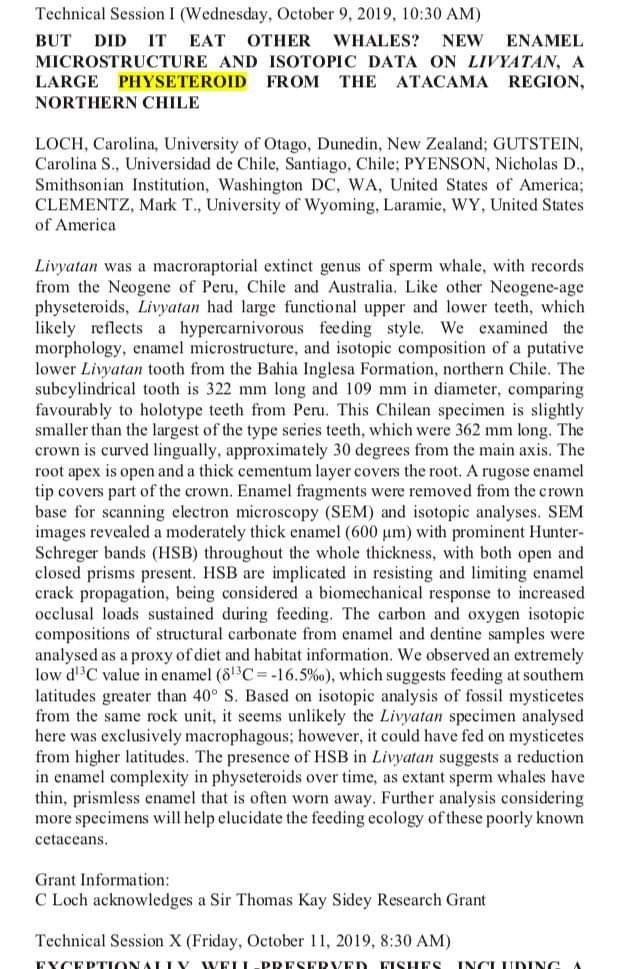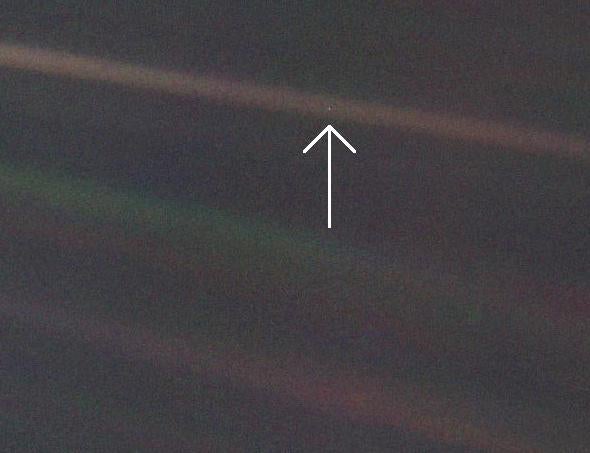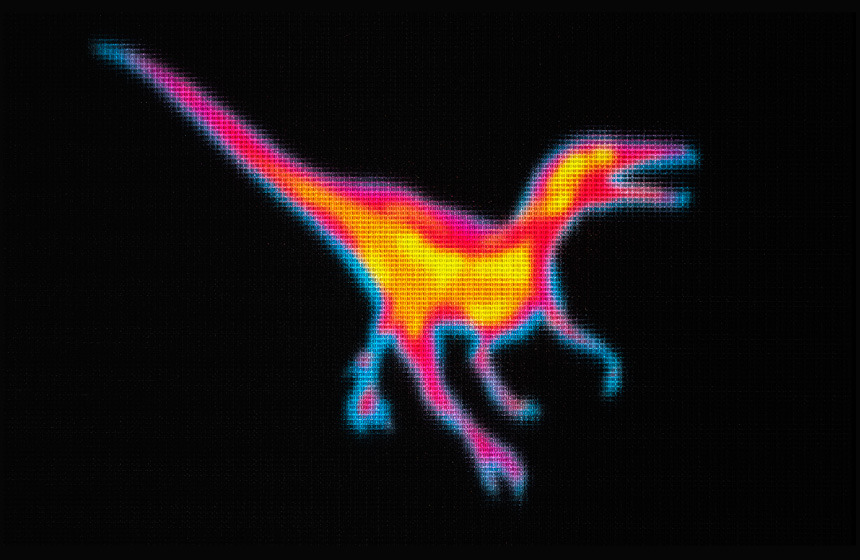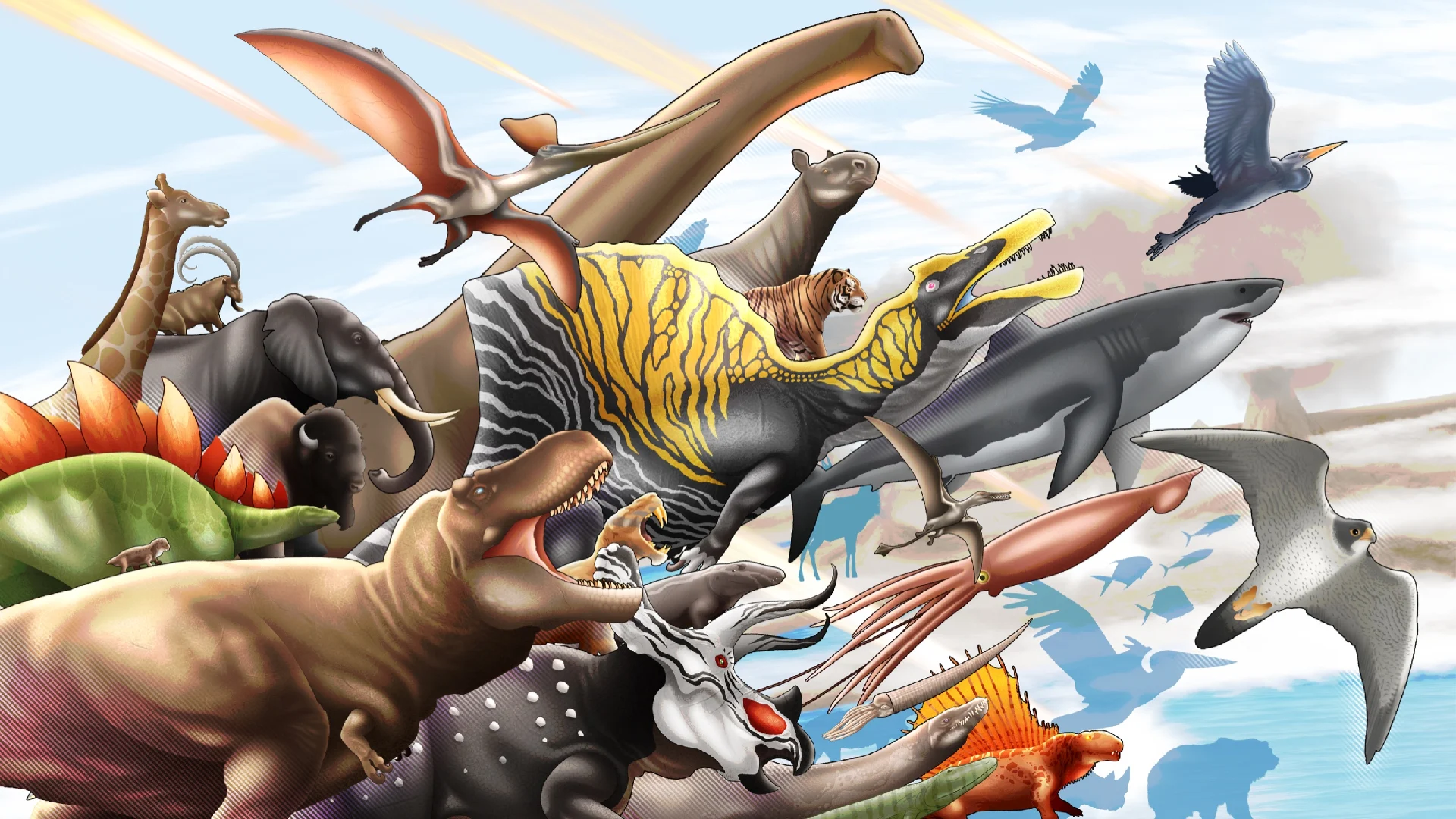|
|
Post by elosha11 on Jun 13, 2021 20:28:06 GMT 5
How would the jaw gape comparison look now that the yorktown meg is at 65 feet long? The Yorktown Megalodon's associated dentition represents a fairly large, but not maximum sized, animal. I think the Yorktown set represents something like a 16 to 17 meter shark. I don't recall the widest anterior/lateral tooth in the Yorktown set, but it is significantly smaller than the largest known teeth. The researchers based their 65ft estimate on the Gordon Hubbell tooth, which they thought was likely a lateral 1 or lateral 2. That tooth is one of the largest, although not necessarily the very largest, tooth known to science. It was meticulously measured by the researchers. That being said, which animal could open its jaws wider, and thus had the greater gape angle is an open question. Sam1 has posted pictures of sperm whales opening their mouths to much greater than would be expected gape angles, but I'm not sure whether Livyatan's much thicker jaws and bone structure would do the same. On the other hand, we know lamnid and other predatory sharks usually have a very wide gape. As to the size of the bite, we can assume Livyatan's longer nostrum means it could bite more deeply across the surface of a competitor / prey, but OTOH, Megalodon's jaws were substantially wider, as well as quite deep. We've had multiple discussions about this before, but I still remain of the opinion that Megalodon likely had a more voluminous bite at parity. And if it was significantly larger than the Livyatan, that bite volume difference would only be amplified at maximum size. |
|
hypezephyr
Junior Member Rank 1
 “Tetrapod superiority!”
“Tetrapod superiority!”
Posts: 5
|
Post by hypezephyr on Jun 16, 2021 7:01:08 GMT 5
Ah, I see. Thanks for the reply!
|
|
hypezephyr
Junior Member Rank 1
 “Tetrapod superiority!”
“Tetrapod superiority!”
Posts: 5
|
Post by hypezephyr on Jun 16, 2021 10:33:41 GMT 5
Speaking of jaw gapes tho, I tried my hands at trying to compare a 65 foot megalodon’s jaw to that of a 60 foot livyatan   They’re not as accurate as Sam1’s model (obviously) but this is more or less just a rough digital comparison between the 2 and their jaws side to side. The Livyatan’s jaws are still a tad-bit greater than the meg if we use the 75* degree jaw gape model Sam1 proposed but they’re mostly equal. If we use the Livyatan 45* degree jaw gape model tho, even the regular 60 ft meg by far exceeds the livyatan’s jaw gape. Its also interesting to note that the livyatan’s jaws (75 degree or 45 degree) are too elongated but not wide enough to fit the mid section of a 65 foot meg in its jaw. The only way a livyatan can use its jaw against the meg is if it scrapes the meg’s side with the upper frontward teeth or target the thinner rear tail. This is made worse with the fact its teeth are conical, meaning the upper teeth need the help of the bottom teeth placement in order to direct full pressure at its point to puncture prey. With a 65 foot meg’s mid torso being bigger than a livyatan’s head and jaw gape, I imagine this is gonna be as hard as trying to chew a watermelon with your teeth alone. Maybe this is something someone else could correct me on? Because if correct, the livyatan is at a severe mismatch here based on the fact it can only target a specific portion of the meg whereas the meg could target most portions of the livyatan indiscriminately. One thing the livyatan could do tho is to ram the meg instead of biting it. Edit: I really wish I could remove those cheeks on the meg tho. Attachments:
|
|
|
|
Post by Infinity Blade on Jun 16, 2021 16:35:44 GMT 5
Stupid question but which image depicts which gape? For some reason the two comparisons on top look similar to each other.
|
|
hypezephyr
Junior Member Rank 1
 “Tetrapod superiority!”
“Tetrapod superiority!”
Posts: 5
|
Post by hypezephyr on Jun 17, 2021 6:03:26 GMT 5
The ones on top are both the same. Its just that the animals are differently placed in each image.
The first image is depicting the meg's jaw gape and the liv's jaw gape side to side if their lower jaws were put at the same level.
The second image on the other hand is just the same image but the Livyatan and Meg's jaws are poised in the way they would use them to bite their prey.
The second one compares their jaw gapes better tho if you're looking for an image more similar to Sam1's image.
The attachment below is just an image that was accidentally placed there.
I was attempting to somehow fit a stoutnosed meg's model on the great white shark's jaw anatomy in the bottom pic just for reference.
|
|
|
|
Post by kekistani on Jun 17, 2021 22:34:39 GMT 5
The ones on top are both the same. Its just that the animals are differently placed in each image. The first image is depicting the meg's jaw gape and the liv's jaw gape side to side if their lower jaws were put at the same level. The second image on the other hand is just the same image but the Livyatan and Meg's jaws are poised in the way they would use them to bite their prey. The second one compares their jaw gapes better tho if you're looking for an image more similar to Sam1's image. The attachment below is just an image that was accidentally placed there. I was attempting to somehow fit a stoutnosed meg's model on the great white shark's jaw anatomy in the bottom pic just for reference. Img didn't go through I think EDIT: NV, I see you posted them above, got confused
|
|
|
|
Post by elosha11 on Jun 25, 2022 2:18:06 GMT 5
SVP abstract. It concludes that the isotopic levels do not suggest the Livyatan specimen was completely macrophagous, meaning always consuming large animals. This does possibly suggest that this specimen, at least, was feeding at a lower trophic level than the Megalodons tested in the recent study. I do note that this seems to be determining isotopic levels based on oxygen and carbon composition, whereas the Megalodon study was based on isotopic levels produced by nitrogen. I'm not sure if it makes a difference.  |
|
|
|
Post by Infinity Blade on Jun 26, 2022 4:02:39 GMT 5
If both of these isotope analyses ring true, then Otodus megalodon and Livyatan melvillei were pretty weird animals, in addition to their large size. The shark being an apex predator that ate predators and predators that ate other predators, and the whale, despite its large jaw muscles and teeth almost as big as a two-liter soda bottle, not always eating large prey.
|
|
|
|
Post by theropod on Jun 26, 2022 17:50:56 GMT 5
SVP abstract. It concludes that the isotopic levels do not suggest the Livyatan specimen was completely macrophagous, meaning always consuming large animals. This does possibly suggest that this specimen, at least, was feeding at a lower trophic level than the Megalodons tested in the recent study. I do note that this seems to be determining isotopic levels based on oxygen and carbon composition, whereas the Megalodon study was based on isotopic levels produced by nitrogen. I'm not sure if it makes a difference.  I think we discussed this some years ago, but there still seems to be nothing new on the subject, and no clarification about the results. There are various confounding factors in isotopic analysis, many of which are at play here. Starting with the most apparent; neither Oxygen nor Carbon isotopes are good trophic indicators (Soto et al. 2013, Kelly 2000). Latitude and temperature plays a huge role, and this is acknowledged in the abstract, while conclusions about trophic ecology seem much more doubtful–only logical considering they already found that the individual fed at high latitudes, which would have the predicted effect of lowering oxygen and carbon ratios. Without the actual data (and appropriate baselines) the options for comparison here are limited. We could probably compare Livyatan to O. orca and other odontocetes from the same (southern) latitude, but we don’t know what was used as a baseline in the research leading to that abstract, neither do we know the actual figures for the isotope ratios that they found. We could also maybe compare them to sharks from the same locality, but of course only if we had data for the same isotopes for both. So what isotopes are used matters a lot, consider for example the contradicting results of two recent studies on O. megalodon trophic ecology; one used Nitrogen isotopes and found extremely high trophic position (Kast et al. 2022), the other used zinc isotopes and found feeding at a trophic level similar to coexisting C. carcharias (McCormack et al. 2022). For comparing two taxa, one should compare the same isotopes (and also the same provenance, of course), not different isotopes that are known to be affected differently by the provenance of the samples. That would be less than ideal if there were detailed, repeated studies showing an overarching consensus (but based on different methods), with one taxon only analyzed once, based on a single time, and only based on an abstract giving very little details, it’s clearly not a sound comparison. Another important thing to keep in mind is what "trophic level" actually means. Consider that a large rorqual (feeding on fish or krill) is on the same or a lower lower trophic level than a dolphin or pinniped (feeding on fish or squid). That is important in interpreting several recent isotopic analyses in the context of other data. For example the recent study (McCormack et al. 2022) that found O. megalodon feeding at a similar trophic level to C. carcharias; this does not mean it necessarily fed on the same (sized) prey, in fact it could have conceivably fed on mysticetes without having a higher trophic level than a C. carcharias feeding on pinnipeds.
I get the impression (from how frequently this gets posted in AvA topics, especially ones about O. megalodon) that trophic level gets conflated with how "formidable" a predator or its prey is perceived to be, but, counterintuitively, this is not a correct interpretation. I think we would all agree that preying on a humpback whale is a lot more impressive than preying on a sea lion, but the trophic level is the same (and the trophic level from feeding on a Rorqual more specialized in krill than fish might be even lower). Hublin, J.-J., Eagle, R.A. and Tütken, T. 2022. Trophic position of Otodus megalodon and great white sharks through time revealed by zinc isotopes. Nature Communications 13 (1): 2980.
Kast, E.R., Griffiths, M.L., Kim, S.L., Rao, Z.C., Shimada, K., Becker, M.A., Maisch, H.M., Eagle, R.A., Clarke, C.A., Neumann, A.N., Karnes, M.E., Lüdecke, T., Leichliter, J.N., Martínez-García, A., Akhtar, A.A., Wang, X.T., Haug, G.H. and Sigman, D.M. 2022. Cenozoic megatooth sharks occupied extremely high trophic positions. Science Advances.
Kelly, J.F. 2000. Stable isotopes of carbon and nitrogen in the study of avian and mammalian trophic ecology. Canadian journal of zoology 78 (1): 1–27.
McCormack, J., Griffiths, M.L., Kim, S.L., Shimada, K., Karnes, M., Maisch, H., Pederzani, S., Bourgon, N., Jaouen, K., Becker, M.A., Jöns, N., Sisma-Ventura, G., Straube, N., Pollerspöck, J., Hublin, J.-J., Eagle, R.A. and Tütken, T. 2022. Trophic position of Otodus megalodon and great white sharks through time revealed by zinc isotopes. Nature Communications 13 (1): 2980.
Soto, D.X., Wassenaar, L.I. and Hobson, K.A. 2013. Stable hydrogen and oxygen isotopes in aquatic food webs are tracers of diet and provenance. Functional Ecology 27 (2): 535–543.
|
|
|
|
Post by Grey on Jun 26, 2022 18:57:19 GMT 5
Yup. The difference is that humpback-sized baleen whales don't seem to be frequent in a Cenozoic up until the Plio-Pleistocene where other than Livyatan and Otodus numerous large sharks and raptorial odontocetes comparable or larger than C. carcharias and O. orca were present. I agree this abstract regarding Livyatan needs an update, it could alternatively suggest this Livyatan did not prey on baleen whales but on large fishes or large cephalopods under this latitude.
Regarding Kast 2022 and McCormack 2022, Pyenson in the accompanying focus notes the later confirms many of Kast conclusions although it finds more overlap with the white shark, which is not surprising since a wider diet has been detected by Kast in the later megs.
Fascinating stuff anyway.
|
|
|
|
Post by Life on Sept 5, 2022 3:48:19 GMT 5
Yup. The difference is that humpback-sized baleen whales don't seem to be frequent in a Cenozoic up until the Plio-Pleistocene where other than Livyatan and Otodus numerous large sharks and raptorial odontocetes comparable or larger than C. carcharias and O. orca were present. I agree this abstract regarding Livyatan needs an update, it could alternatively suggest this Livyatan did not prey on baleen whales but on large fishes or large cephalopods under this latitude. Regarding Kast 2022 and McCormack 2022, Pyenson in the accompanying focus notes the later confirms many of Kast conclusions although it finds more overlap with the white shark, which is not surprising since a wider diet has been detected by Kast in the later megs. Fascinating stuff anyway. Contrary to popular belief, Baleen whale gigantism is not a recent phenomenon. Genus Llanocetus, one of the earliest known baleen whales, approached 12m in TL back in the Eocene epoch. Gigantic baleen whales are also noticed in the Miocene epoch. Genus Pelocetus emerged in the Mid-Miocene timeline; fossilized remains are found in Maryland (North American waters) and Peru (South American waters). Members of this genus were large-bodied and migratory much like modern baleen whales with individuals approaching 12m in TL. Fossilized remains found in Maryland belong to a specimen that lost its life to a Megalodon.
Even bigger baleen whales (balaenopterids) are noticed in Peru in the Late Miocene timeline with individuals exceeding 15m in TL. Japanese deposits have disclosed additional examples of gigantic baleen whales that emerged in the Miocene epoch.
Assumption is that large body size evolved for different reasons and in response to different ecosystem conditions. References
Bianucci, G., Marx, F. G., Collareta, A., Di Stefano, A., Landini, W., Morigi, C., & Varola, A. (2019). Rise of the titans: baleen whales became giants earlier than thought. Biology Letters, 15(5), 20190175. Marx, F. G., Buono, M. R., Evans, A. R., Fordyce, R. E., Reguero, M., & Hocking, D. P. (2019). Gigantic mysticete predators roamed the Eocene Southern Ocean. Antarctic Science, 31(2), 98-104. Tsai, C. H., & Kohno, N. (2016). Multiple origins of gigantism in stem baleen whales. The Science of Nature, 103(11), 1-8.
Tsai, C. H. (2017). A Miocene breeding ground of an extinct baleen whale (Cetacea: Mysticeti). PeerJ, 5, e3711.
----
It is also wrong to assume that small baleen whales became extinct in the Pliocene epoch. The pygmy right whale Caperea marginata is a cetotheriid in fact.
Additional examples include the pygmy blue whale Balaenoptera musculus brevicauda and minke whales such as Balaenoptera acutorostrata and Balaenoptera bonaerensis respectively.
References
Boessenecker, R. W. (2013). Pleistocene survival of an archaic dwarf baleen whale (Mysticeti: Cetotheriidae). Naturwissenschaften, 100(4), 365-371.
Leroy, E. C., Royer, J. Y., Alling, A., Maslen, B., & Rogers, T. L. (2021). Multiple pygmy blue whale acoustic populations in the Indian Ocean: whale song identifies a possible new population. Scientific Reports, 11(1), 1-21.
Perrin, W. F., Mallette, S. D., & Brownell Jr, R. L. (2018). Minke whales: Balaenoptera acutorostrata and B. bonaerensis. In Encyclopedia of marine mammals (pp. 608-613). Academic Press.
|
|
|
|
Post by Grey on Sept 5, 2022 3:59:03 GMT 5
Yup I know of those large-sized whales. There were 10 m plus cetaceans back then but they were not the most numerous and not quite yet at the scale of the gigantic Plio-Pleistocene post-meg baleen whales.
With the possibility of megalodon being primarily a predator of top predators (Kast 2022), maybe those whales were not primary targets for the big fish.
|
|
|
|
Post by Life on Sept 5, 2022 15:15:16 GMT 5
Yup I know of those large-sized whales. There were 10 m plus cetaceans back then but they were not the most numerous and not quite yet at the scale of the gigantic Plio-Pleistocene post-meg baleen whales. With the possibility of megalodon being primarily a predator of top predators (Kast 2022), maybe those whales were not primary targets for the big fish. It depends upon how WE look at the whole thing. There was a radiation of small baleen whales in the Oligocene epoch followed by another radiation in the Miocene epoch. These occurrences created (small > large) eco-balance of baleen whales for a period of time in each epoch. Sea-level oscillations due to climatic shifts and stabilization of food-rich polar regions due to the overarching global cooling trend have removed many of the small baleen whales from the equation. Now large-bodied baleen whales are relatively common; (large > small) eco-balance of baleen whales in current times. Peruvian sediments showcase a marked shift from (small > large) eco-balance of baleen whales in Mid-Miocene timeline to (large > small) eco-balance of baleen whales in the Late Miocene timeline. My take is that humpback-sized baleen whales were NOT uncommon in the Miocene epoch [post-MMCO]. Outnumbered in some regions? YES. Truly gigantic baleen whales began to emerge in the Late Miocene timeline; specimen approaching and/or exceeding 15m in TL noticed in Peruvian sediments for instance. Blue whale proportions are FIRST noticed in the Plio-Pliestocene transition period. But people will continue to dig and find out more in time. |
|
|
|
Post by Grey on Sept 5, 2022 15:58:48 GMT 5
Kallal et al. 2010 rib fragment and its purpoted whole size.  |
|
|
|
Post by Life on Sept 5, 2022 16:17:39 GMT 5
Kallal et al. 2010 rib fragment and its purpoted whole size.   You rock, my man. |
|















